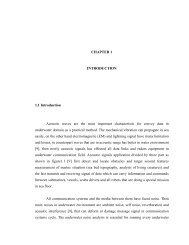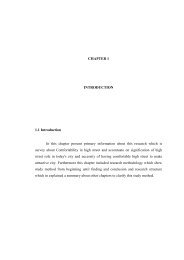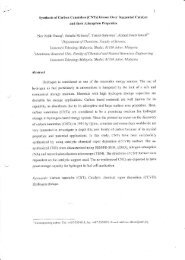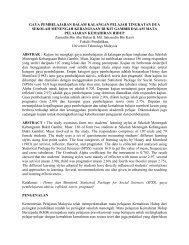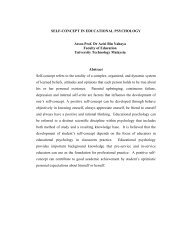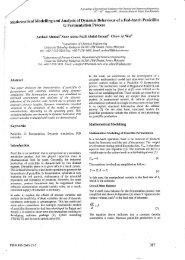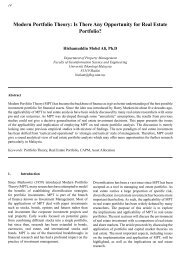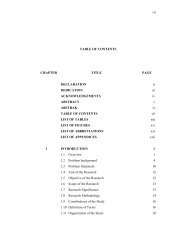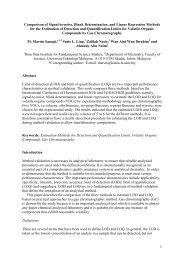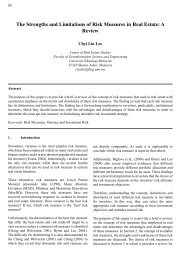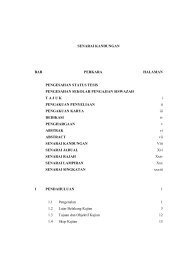Rational approach to the selection of conditions for diastereomeric ...
Rational approach to the selection of conditions for diastereomeric ...
Rational approach to the selection of conditions for diastereomeric ...
You also want an ePaper? Increase the reach of your titles
YUMPU automatically turns print PDFs into web optimized ePapers that Google loves.
1346 F. C. Ferreira et al. / Tetrahedron: Asymmetry 17 (2006) 1337–1348<br />
Kd 2R ¼ ½AS2Š t<br />
W AS2<br />
½A 2 Š ML<br />
½RH þ Š 2 ML<br />
ð10bÞ<br />
Kd 2S ¼ ½AS2Š t<br />
W AS2<br />
½A 2 Š ML<br />
½SH þ Š 2 ML<br />
ð11bÞ<br />
Also Kd 2R ¼ Kd 1R Kd 1 0 R and Kd 2S ¼ Kd 1S Kd 1 0 S.<br />
Assumptions 5–7 also hold <strong>for</strong> <strong>the</strong> more complex model<br />
and <strong>the</strong>re<strong>for</strong>e <strong>the</strong> same values <strong>for</strong> <strong>the</strong> Kd constants are<br />
used in both models. Additionally, model II assumes <strong>the</strong><br />
same acid–base equilibrium constant (K amine ) <strong>for</strong> both<br />
amine enantiomers (Assumption 6).<br />
Each model is a system <strong>of</strong> algebraic equations and was<br />
solved using gPROMs, a commercially available ma<strong>the</strong>matical<br />
package from Process Systems Enterprise Ltd<br />
(UK). The last four equations (Eqs. 18–21) are used <strong>to</strong> calculate<br />
<strong>the</strong> model outputs.<br />
and dried at room temperature <strong>for</strong> 24 h, and weighed. This<br />
crystallisation pro<strong>to</strong>col is a modification <strong>of</strong> <strong>the</strong> method<br />
previously reported <strong>for</strong> <strong>the</strong> resolution <strong>of</strong> 2-amino-1-<br />
phenylethanol. 3<br />
5.2.2. PPI2. Ace<strong>to</strong>ne–water 97:3 wt % homogeneous solution<br />
was employed as resolution solvent <strong>for</strong> PPI2. Resolution<br />
was per<strong>for</strong>med by mixing 10 ml <strong>of</strong> a solution <strong>of</strong><br />
560 mM PPI2 in this solvent with an equal volume <strong>of</strong> ( )-<br />
DTTA solution in <strong>the</strong> same solvent. Again, <strong>the</strong> amounts <strong>of</strong><br />
( )-DTTA varied according with <strong>the</strong> C value sought. The<br />
two solutions were pre-heated at 40 °C and added <strong>to</strong>ge<strong>the</strong>r.<br />
The resulting solution was stirred at 40 °C <strong>for</strong> half an hour,<br />
and <strong>the</strong>n allowed <strong>to</strong> cool down under stirring at room temperature<br />
<strong>for</strong> a half hour, and finally aged <strong>for</strong> 1 h at 4 °C.<br />
The crystals obtained were filtered under vacuum and<br />
washed with resolution solvent.<br />
Yield ð%Þ ¼ W AS þ 2 W AS2<br />
100<br />
½SŠ 0<br />
þ½RŠ 0<br />
ð18Þ<br />
ee ð%Þ ¼ ðW AS þ 2 W AS2 Þ ðW AR þ 2 W AR2 Þ<br />
ðW AS þ 2 W AS2 ÞþðW AR þ 2 W AR2 Þ 100<br />
ð19Þ<br />
pH ¼ Log½H þ Š ð20Þ<br />
ee ML ð%Þ ¼ ð½SŠ t;ML þ½ASŠ ML þ 2 ½AS2Š ML Þ ð½RŠ t;ML þ½ARŠ ML þ 2 ½AR2Š ML Þ<br />
ð½SŠ t;ML<br />
þ½ASŠ ML<br />
þ 2 ½AS2Š ML<br />
Þþð½RŠ t;ML<br />
þ½ARŠ ML<br />
þ 2 ½AR2Š ML<br />
Þ 100<br />
ð21Þ<br />
5.1. Materials<br />
5. Experimental<br />
Solvents (HPLC grade) were obtained from Aldrich–Sigma<br />
UK. Pure (R)- and (S)-enantiomers and a racemic mixture<br />
<strong>of</strong> PEA were also supplied by Aldrich–Sigma UK. (+)-Di-<br />
O,O 0 -p-<strong>to</strong>luyl-D-tartaric acid and ( )-di-O,O 0 -p-<strong>to</strong>luyl-Ltartaric<br />
acid, that is, (+)-DTTA and ( )-DTTA, were<br />
supplied by Fluka UK. Racemic PPI2 and pure S-PPI enantiomer<br />
were supplied by GSK Ltd. R-PPI was obtained<br />
throughout resolution <strong>of</strong> racemic PPI2 with (+)-DTTA<br />
according <strong>to</strong> <strong>the</strong> resolution pro<strong>to</strong>col described below.<br />
5.2. Resolution pro<strong>to</strong>cols<br />
5.2.1. PEA. Isopropanol–water 50:50 wt % homogeneous<br />
solution was employed as resolution solvent. Racemic PEA<br />
and (+)-DTTA were dissolved in separate 2.5 ml aliquots<br />
<strong>of</strong> this solvent at 55 °C. The concentration <strong>of</strong> racemic<br />
PEA in 2.5 ml was fixed at a value <strong>of</strong> 352 mM. The amount<br />
<strong>of</strong> (+)-DTTA added was varied according <strong>to</strong> <strong>the</strong> final C<br />
value sought. The two clear 2.5 ml solutions were preheated<br />
at 55 °C and added <strong>to</strong>ge<strong>the</strong>r at this temperature;<br />
<strong>the</strong> resulting 5 ml solution was also clear. The solution<br />
was stirred <strong>for</strong> 1 h at 55 °C, and <strong>the</strong>n allowed <strong>to</strong> cool down<br />
until 40 °C. After stirring <strong>for</strong> a fur<strong>the</strong>r hour at this temperature,<br />
<strong>the</strong> solution was allowed <strong>to</strong> cool down until 25 °C<br />
and stirred <strong>for</strong> fur<strong>the</strong>r 24 h. The resulting solid was separated<br />
by vacuum filtration, washed with resolution solvent<br />
5.3. Analysis<br />
PEA and PPI2 amine concentrations and ee analysis were<br />
carried out by HPLC. For PEA, a Unicam Crystal 200<br />
HPLC was used, with <strong>the</strong> mobile phase comprising 90% hexane–10%<br />
isopropanol–0.1% ethanolamine and flowing at a<br />
rate <strong>of</strong> 0.75 ml min 1 <strong>for</strong> 20 min per analysis through a<br />
Daicel OD-H chiral (5 mm, 250 mm · 0.46 mm) column,<br />
with a UV detec<strong>to</strong>r wavelength adjusted <strong>to</strong> 254 nm. In <strong>the</strong><br />
case <strong>of</strong> PPI2 analyses, a Gilson 712 HPLC was used, with<br />
<strong>the</strong> mobile phase comprising 95% acetronitrile–5% methanol–0.02%<br />
trifluoroacetic acid–0.01% ammonia and flowing<br />
at a rate <strong>of</strong> 0.70 ml min 1 through a Cyclobond I 2000 AC<br />
(5 mm, 250 mm · 0.46 mm) column, with <strong>the</strong> UV detec<strong>to</strong>r<br />
wavelength adjusted <strong>to</strong> 265 nm. For analysis, an aliquot <strong>of</strong><br />
mo<strong>the</strong>r liquor or solid was dissolved in NaOH (2 M) and extracted<br />
in<strong>to</strong> mobile phase or DCM, respectively <strong>for</strong> PEA or<br />
PPI analysis. Calibrations have been prepared accordingly.<br />
Experimentally, ee’s and Y’s were estimated as<br />
ee ¼ mol S W mol R W<br />
100<br />
ð22Þ<br />
mol S W þ mol R W<br />
ee ML ¼ mol S ML mol R ML<br />
100 ð23Þ<br />
mol S ML þ mol R ML<br />
mol S W<br />
Yield ¼<br />
100<br />
ð24Þ<br />
mol S 0 þ mol R 0<br />
Analyses <strong>of</strong> DTTA were also carried out using a 712<br />
Gilson HPLC, but with a Phenomex Luna C18 (2)



